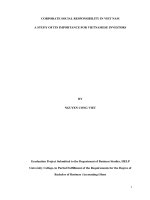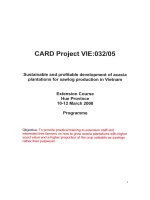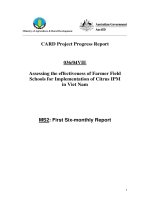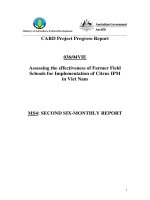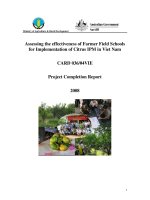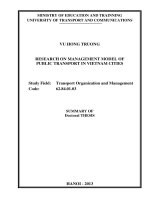Status of Pangasiid aquaculture in Viet Nam
Bạn đang xem bản rút gọn của tài liệu. Xem và tải ngay bản đầy đủ của tài liệu tại đây (1.35 MB, 18 trang )
Mekong River Commission
Status of Pangasiid aquaculture
in Viet Nam
MRC Technical Paper
No. 2
April 2002
Report prepared by the MRC Fisheries Programme at the request of the
Technical Advisory Body on Fisheries Management in the Lower Mekong Basin
Published in Phnom Penh in April 2002 by
the Mekong River Commission
This document should be cited as:
Trong, Trinh Quoc, Nguyen Van Hao and Don Griffiths. 2002. Status of Pangasiid aquaculture in Viet
Nam. MRC Technical Paper No. 2, Mekong River Commission, Phnom Penh. 16 pp. ISSN: 1683-
1489.
The opinions and interpretations expressed within are those of the authors
and do not necessarily reflect the views of the Mekong River Commission.
Editor: Ann Bishop
© Mekong River Commission
P.O. Box 1112, 364 M.V. Preah Monivong Boulevard
Phnom Penh, Cambodia
Telephone: (855-23) 720-979 Fax: (855-23) 720-972
E-mail:
Website: www.mrcmekong.org
Acknowledgements
This report was prepared under the auspices of the Rural Extension for Aquaculture Development
(READ) Project. READ was a collaborative venture between the Departments of Fisheries in Viet
Nam and Cambodia and the Fisheries Programme of the Mekong River Commission. Financial
support for READ was provided by the government of Denmark (through DANIDA).
The authors wish to thank staff of the following agencies for their assistance in compiling this
document: the Research Institute for Aquaculture Number 2, in Ho Chi Minh City; Can Tho
University; and the Cai Be Research Centre for Aquaculture.
Background of the Working Group on Mekong Giant Fish Species
The Technical Advisory Body on Fisheries Management (TAB) of the Mekong River
Commission (MRC) was established in June 2000. The TAB gives advice to the
MRC Fisheries Programme on technical issues relating to basin-wide fisheries
management. During the first meeting, five main issues were identified. Among these
was the following:
Management of Pangasius (River catfish)
The Meeting considered under this item in particular, Pangasianodon
hypophthalmus. The size of fish caught has been declining, pointing to
overexploitation. A fry fishery for aquaculture purposes, while illegal in some
countries, may still be taking place. Fry of other species are also being caught as
unwanted by-catch. The TAB is concerned about this situation.
It was agreed that the MRC Fisheries Programme (Cambodian Capture Fisheries
Component, Assessment of Mekong Fisheries Component and Aquaculture Extension
Component) shall produce two "status reports" on Pangasianodon hypophthalmus,
summarising what is presently known on spawning and feeding habits, migrations of
fry and adult fish, fishing efforts and possible management interventions, as well as
the use of the species for aquaculture, the status of artificial breeding, and an
assessment of whether increased availability of artificially-produced fry might
eliminate the collection of wild fry. The report will be submitted to the TAB.
Table of Contents
Summary 1
1. Back ground 3
2. Status of wild river catfish larvae 3
3. Status of hatchery seed production 4
4. Status of culture 6
4.1 Pond culture 6
4.2 Cage culture 7
5. References 9
Appendix I 11
Appendix II 12
Appendix III 13
Status of Pangasiid aquaculture in Viet Nam
Summary
Wild caught river catfish (Pangasianodon hypophthalmus) from the Mekong River have been an
extremely popular food fish in Viet Nam for centuries. This report details the developments that have
produced impressive increases in cultured production of river catfish over the last two decades.
Information is provided on the wild seed fishery, technical developments in breeding and nursing of river
catfish and culture methods, including pond and cage culture systems, illustrated with photographic
examples. Cultured river catfish production data by culture systems are also listed for provinces in the
Mekong River delta area of Viet Nam.
Culture of river catfish, first reliant upon wild seed caught seasonally each year, has also been conducted
for centuries. As pond and cage culture operations expanded in Viet Nam and also Cambodia, wild stocks
of river catfish seed were decimated through over-fishing and destructive fishing methods.
In the early 1980s hatchery operators in Viet Nam first mastered spawning and later in the 1990s nursing
of river catfish. As a result cultured production of river catfish soared, reaching an estimated 20,000
metric tonnes by 1999.
This report synthesises in a single readable volume, important information only previously available in
Vietnamese and French reports and scientific papers. The historical information and the present status of
river catfish culture in Viet Nam are of national and regional significance to both technical staff and
policy decision makers within the aquatic resources sector. In addition this report gives specific examples
of the interaction between wild capture fisheries and aquaculture, neither of which can be considered in
isolation.
Status of Pangasiid aquaculture in Viet Nam
3
1. Background
River catfish have been cultured for centuries in ponds in the Mekong delta of Viet Nam (Peignen 1993,
cited by Cacot 1999), and today are an important culture species. Annual production is estimated at
20,000 tonnes, which is sufficient to meet the demand of domestic markets (Cacot 1999).
P. hypophthalmus have air-breathing organs and are obligate air breathers (Browman and Kramer 1985;
cited by Cacot 1999). This enables river catfish to tolerate poor water quality, including high organic
matter or low dissolved oxygen levels, and they can therefore be stocked at high densities. River catfish
are omnivorous. When cultured in ponds and cages, they will accept trash fish, pellets, home-made feed
formulated from agro- and fishery by-products, water plants and even animal and human wastes. In Viet
Nam, river catfish are commonly stocked in ponds with latrines over hanging them.
2. Status of wild river catfish larvae
A series of studies have failed to find any river catfish spawning grounds in Viet Nam (Ministry of
Fisheries, cited by Khanh 1996). Early in the monsoon season, wild adult river catfish migrate out of the
Great Lake and go down the Tonle Sap river, before swimming up the Mekong river to spawn below the
Khone Falls on the Lao-Cambodian border (See Map, Appendix I). There, environmental conditions are
suitable for gonad development and breeding (MRC 1992).
Traditionally, river catfish culture systems in Viet Nam relied entirely on wild caught fry, with 200-800
million fry being caught annually (Department of Freshwater Fisheries 1977; Department of Agriculture
of An Giang province 1977; cited by Khanh 1996). Following spawning, fixed bag nets, typically 10-15 m
long, with mouths 5 m wide (see Appendix II) were used to catch river catfish fry migrating back down
stream. The start of the fry-catching season was linked to the arrival of highly turbid water from up stream
(MRC 1992; cited by Phuong 1998). At Tan Chau and Hong Ngu in Viet Nam, this begins in early May
and continues for two lunar cycles. The static fishing gear (or dai in Vietnamese) is generally placed 15-
30 metres (and up to a maximum of 100 metres) from the riverbank in areas sheltered from wind and
waves, with an even stream flow. Fry are classified by size and colour into three categories. These are 1.3-
1.5 cm, 1.5-1.7 cm, and 1.7-2.0 cm, or silver, pink and black, respectively (Department of Freshwater
Fisheries 1977; Department of Agriculture of An Giang province 1977; Tien 1995; cited by Khanh 1996).
Fine meshed nylon has been used for the bag net or dai fishery. In the process of catching catfish fry,
unwanted fry of other species were also caught, which were then discarded. This made the fishery for
river catfish fry highly destructive. An estimated 5-10 kg of other fish species were killed for each kilo of
river catfish fry caught (Phuong 1998). The quantity of wild-caught river catfish fry declined tenfold in a
decade because of over-fishing for fry (Department of Aquatic Natural Protection of Dong Thap province,
cited by Khanh, 1996).
Recognition of this problem and the successful artificial spawning of river catfish led to the banning of the
fishery for wild river catfish fry in both An Giang and Dong Thap provinces in February 2000 (see below
for additional detail).
Status of Pangasiid aquaculture in Viet Nam
4
3. Status of hatchery seed production
Artificial propagation of river catfish was first achieved in Thailand in 1959 (Boonbrahm 1959, cited by
Cacot 1999). Since then it has been done in Indonesia (Hardjamulia et al. 1981; cited by Cacot 1999) and
in Malaysia (Thalathiah et al. 1983; cited by Cacot 1999).
Since 1978, research on artificial propagation of river catfish in Viet Nam has been undertaken by various
institutions. These include the Fisheries Faculty, University of Agriculture No. 4, Thu Duc, Ho Chi Minh
City, in cooperation with Long Dinh Agriculture Vocational School, Tien Giang province. The first fry
were produced in 1979 and greater quantities of fry and fingerlings were produced over time. The
Research Institute for Aquaculture No.2 (RIA 2) and Can Tho University, both began induced spawning
trials with river catfish in 1981. The history of the successful development of artificial propagation
techniques for river catfish over two decades is well documented in a Vietnamese-language doctoral thesis
entitled ''Induced spawning of the river catfish Pangasianodon hypophthalmus in the Mekong Delta"
(Khanh 1996).
Sexual maturation of P. hypophthalmus takes more than three years. The development of the technique to
remove oöcytes by intra-ovarian canulation and diameter measurement using a binocular microscope, in
order to assess readiness of females for spawning, was vital to successful induced spawning of Pangasiids,
and especially of P. hypophthalmus and P. bocourti (Cacot 1999).
In the 1980s, nursery survival rates of P. hypophthalmus were very low (<5%). Early researchers in Viet
Nam thought that hatchling river catfish were initially too small to rear in earthen ponds. High mortality
rates were caused by cannibalism and bacterial infection (Aeromonas hydrophila) – problems caused by
rearing hatchlings at densities which were too high. Hung (2000) reported that hatchling river catfish had
mouths large enough to take live feed such as Cladocera (Moina and Daphnia). Nursery survival rates
were significantly improved by using such feed and by releasing hatchlings into earthen ponds within 20-
24 hours of hatching. Today it is normal practice to stock hatchlings into properly-prepared earthen ponds
just prior to yolk sac absorption. Thus natural feeds are immediately available when yolk sac absorption is
complete. Also fry have enough space to avoid cannibalism (Hung 2000). Typical fry survival rates are
now 60-70 percent.
As indicated in Table 1, Dong Thap Fish Experimental Station replicated the successful induced spawning
of river catfish, producing 250 million fry in 2000 (Ro 2000). River catfish seed production has increased
since artificial propagation became routine and both An Giang and Dong Thap provinces have banned the
fishery for wild river catfish fry. As shown in Tables 1, 2 and 3, private seed producers have recently
entered the river catfish seed market, with technical support provided by both the government and private
companies. Today the private sector plays an important role in river catfish seed production. The Cai Be
Research Center for Aquaculture in the Mekong delta, under RIA-2 (known as the Cai Be Fish Farm), has
also become an important supplier of river catfish fry and fingerlings in Tien Giang province (Table 3).
Table 1 shows the number of river catfish fry and fingerlings produced annually in Dong Thap province,
Table 2 shows the same data for AGIFISH of An Giang province and Table 3 the total production for the
Viet Nam lower Mekong delta area.
Status of Pangasiid aquaculture in Viet Nam
5
Table 1 P. hypophthalmus seed production in Dong Thap province, 1998 -2000
Broodstock Fry
(million)
Fingerlings
(million)
Year
Number of
producers
Number Tonnes Number Number
1998 1 378
2.0 6 2.2
1999 17 3,000
12.0 350 150.0
2000 50 20,500
102.5 750 250.0
Source: Department of Natural Protection of Dong Thap Province, cited by Ro, 2000.
Table 2 Number of P. hypophthalmus fry produced by AGIFISH Co.
(An Giang)
Year Number of fry
1996 9,950
1997 1,850,000
1998 72,391,881
1999 93,272,400
2000* 24,218,259
Total 191,218,259
Note: * To September 2000.
Source: Hung 2000, AGIFISH Company, An Giang Province.
Table 3 Quantity of river catfish fry and fingerlings (mainly P. hypophthalmus),
produced in the Mekong delta of Viet Nam
Producer 1998 1999
An Giang 80 million >100 million
Dong Thap 20 million >150 million*
Cai Be Research Center 20 million
Total 100 million >270 million
Note: * Dong Thap Experimental Station on Aquatic Seed Production produced
20 million, four private farms produced the remainder.
Source: Nguyen Bang (1999).
Although Chau Thanh was the first (1997-98) major induced spawning area for P. hypophthalmus in
Dong Thap province, spawning has since expanded rapidly and is now concentrated in Hong Ngu district.
It supplies P. hypophthalmus and P. bocourti seed for intensive cage culture systems in Hong Ngu district
adjacent to the border with Cambodia. Increasing numbers of hatcheries and nurseries supplying
Pangasiid seed led to over-supply in 2000. The seed production network can now guarantee sufficient
hatchery produced seed to meet the needs of the river catfish culture in the Mekong delta area of Viet
Nam. It is claimed that only some 8–10 million P. bocourti are bought from Cambodia each year for use
in cage culture, because hatchery production is not yet sufficient. However, many grow-out farmers
believe riverine fish fry to be of superior quality.
Status of Pangasiid aquaculture in Viet Nam
6
4. Status of culture
Pangasiids are cultured both extensively and intensively in the Mekong delta, depending on feed
availability, rearing systems and fish species. River catfish are generally cultured in pond and cage culture
systems (Hung and Cacot 2000).
Most pond culture of river catfish is small-scale, so little statistical data are collected on pond production.
Hung and Cacot (2000) estimate that production of river catfish in the delta is about 20,000 tonnes per
year. Table 5 shows that pond production of river catfish in Dong Thap province increased from 3,000 to
4,500 tonnes from 1997 to 2000. Mean total pond production was 20-30 tonnes/ha/year, though a few
ponds achieved production as high as 50 tonnes/ha/year. The 2000 Annual Reports of the Department of
Agriculture of An Giang and Dong Thap provinces give a figure for cage culture production of 45,000
tonnes, which comprises almost equal amounts of P. hypophthalmus and P. bocourti, unlike the 1996 data
presented in Figure 3, which show 85 percent P. bocourti.
4.1 Pond culture
Wild-caught river catfish have traditionally been cultured in household ponds, throughout the Mekong
delta area of Viet Nam, most commonly integrated with livestock, in order to utilise animal wastes.
According to Hung and Cacot (2000), river catfish are suitable for small-scale aquaculture systems and
are often grown in polyculture, with Nile Tilapia (Oreochromis niloticus) and kissing gourami (Helostoma
temmincki). Farmers collaborating in the last three years with the Rural Extension for Aquaculture
Development (READ) Project in the Mekong Delta area have stocked river catfish in polyculture with 11
other fish species, including common carp, silver carp, Indian carp and silver barb. These are stocked in
different proportions, depending on the agro-ecological zone, the availability of on-farm feeds and the
socio-economic status of the household (READ 1998, 1999 and 2000). Because they air breath and can
tolerate poor water quality, P. hypophthalmus are often stocked at densities as high as 20-25 fish per sq m,
in both mono-and polyculture systems.
The production cycle of P. hypophthalmus comprises one single cycle in grow-out ponds (Figure 1). Fish
are usually fed rice bran, broken rice, kitchen scraps and vegetables. In addition, river catfish feed on
natural feed, which develops in ponds fertilised by animal wastes, including those of pigs and humans.
Fish from integrated pond systems often have a muddy off-flavor and the flesh is always darker in colour
than the flesh of river catfish reared in cages. Consumers, and the export market in particular, prefer the
white coloured flesh of P. hypophthalmus reared in cages.
Figure 1 Production cycle for P. hypophthalmus
Source: Hung and Cacot 2000.
Larvae-rearing in earthen ponds
Hatcheries Catching wild fry (10-12 days old)
Grow-out in ponds
Advanced fingerlings grown in cages
1-2 months
Grow-out in cages
Status of Pangasiid aquaculture in Viet Nam
7
4.2. Cage culture
Cage culture started nearly a century ago in Cambodia (Chevey and Le Poulain 1940; Coche 1978; cited
by Hung and Cacot 2000). It was introduced to Viet Nam when Vietnamese refugees fled Cambodia in the
1960s (MRC 1992). Since then, cage culture has continued to develop and is concentrated along the
Vietnamese-Cambodian border in An Giang and Dong Thap provinces in Viet Nam (Phuong 1998).
Figure 2 shows cage production from 1985 to 95 for An Giang and Dong Thap provinces.
Cage culture is an intensive culture system since fish are stocked at very high densities (100 kg/cu m) and
artificial feed is provided as the only nutrient source for fish growth. P. bocourti is the main species
cultured in cages, contributing 85 percent of the total cage production in the Mekong delta. Other
Pangasiids reared in cages are P. hypophthalmus, P. conchophilus, P. larnaudiei and P. conic, and these
contribute 6 percent of total cage production in Viet Nam (Figure 3). Spotted snakehead (Channa
micropeltes) and other Cyprinids, such as silver barb (Barbodes gonionotus) and red-tail tin-foil barb (B.
altus) contribute 5 percent and 4 percent, respectively, to total cage production (Hung and Cacot 2000).
Cage culture development is concentrated in An Giang and Dong Thap provinces in areas with suitable
water currents and locally available supplies of seed and feed (Table 4). Good infrastructure (roads and
waterways), credit systems and processing factories are also advantageous.
P. hypophthalmus is an omnivore that will feed on rice bran, broken rice and corn, cassava flour, trash
fish, fish-meal and vegetables in culture systems. In Viet Nam, rice bran usually contributes two thirds of
the diet during grow -out of P. hypophthalmus. Home-made feeds normally consist mainly of rice bran,
broken rice, trash fish and vegetables. In Viet Nam, cage feeds are prepared, mixed and cooked at site,
with the feed being presented as wet sticky balls.
Table 4 Number of cages in An Giang and Dong Thap provinces
Size categories Household State owned Shareholding Total
Small size 773
18
0 791
Medium size 787
0
0 787
Large size 564
21
35 620
Total 2,124
39
35 2,198
Source: Phuong 1998.
Figure 2 Annual cage culture production in An Giang and Dong Thap provinces
Source: Phuong 1998.
Status of Pangasiid aquaculture in Viet Nam
8
Figure 1 shows a diagrammatic representation of P. hypophthalmus cage culture. Fingerlings obtained
from the nursing ponds are grown in small cages to advanced fingerlings of 100 g and these are stocked
into grow-out cages. In Viet Nam, mean yield of P. hypophthalmus is 88 kg/cu m (Hung and Cacot 2000).
Culture is concentrated in Hong Ngu and Tan Hong districts, though there has been a more recent spread
to other areas, including Thanh Binh, Cao Lanh, and Sa Dec districts. Average production from grow-out
cages is 80-120 kg/sq m/year (Table 5).
Table 5 Status of P. hypophthalmus pond culture in Dong Thap province
Production (tonnes) Year
No. of cages
Water area
(ha)
In Cage In Pond
Total production
(tonnes)
1997 86 150 2,300 3,000 5,300
1998 109 165 2,900 3,500 6,400
1999 120 180 3,600 4,100 8,100
2000 150 200 5,000 4,500 9,500
Source: Ro 2000.
Figure 3 Cage production proportion of different catfish species in the Mekong Delta, in 1996.
Source: Hung and Cacot 2000.
P. hypophthalmus
5%
Channa micropeltes
5%
Cyprinids
4%
P. bocourti
85%
Other Pangasiidds
1%
P. hypophthalmus P. bocourti Other Pangasiidds Channa micropeltes Cyprinids
Status of Pangasiid aquaculture in Viet Nam
9
5. References
Cacot, P. 1999. Étude du cycle sexuel et maitrise se la reproduction de Pangasius bocourti (Sauvage,
1880) et Pangasius hypophthalmus (Sauvage, 1878) dans le delta du Mekong au Viet-Nam,
l’Institut National Agronomique Paris-Grignon, Paris. (Ph.D. thesis)
Hung, L. T., J. Slembrouk, J. Subagja, & M. Legendre. 2000. Study on mass mortality of Pangasius
hypophthalmus during larval rearing and its control and prevention. In: Proceedings of the
National Workshop on Aquaculture, September 29-30, 1998, p. 178-188. RIA 1, Bac Ninh, Viet
Nam.
Hung, L. T. & P. Cacot. 2000. Pangasius catfish culture in the Mekong Delta. In: Proceedings of the
National Workshop on Aquaculture, September 29-30, 1998. RIA 1. Bac Ninh, Viet Nam.
Hung, V. P. 2000. Report on status in seed production, growing-out and advance technologies applied in
culturing of basa fish P. bocourti, In: National inception workshop of aquaculture of indigenous
fish species in the Mekong basin, Ho Chi Minh City, Viet Nam.
Khanh, P. V. 1996. Induced spawning of river catfish Pangasius hypophthalmus in the Mekong Delta of
Vietnam, (in Vietnamese),University of Fisheries, Nha Trang, Viet Nam. (Ph. D. thesis)
Interim Committee for Coordination of Investigations of the Lower Mekong. 1992. Fisheries in the Lower
Mekong Basin, Annex 4 and 5, Bangkok.
Nguyen B. 1999. Status of seed production of fish and shrimp in 1999 of some provinces. The Shrimp
Magazine, #45, Vietnam Aquaculture Society, Viet Nam, 5 pp.
Phuong, N. T. 1998. Pangasius catfish cage culture in the Mekong Delta – Current situation and study for
feeding improvement, Can Tho University, Na Thrang, Viet Nam. (Ph. D. thesis)
Ro, N. T. 2000. Status of seed production and growing-out, as well as applying of advance technologies of
river catfish, In: National inception workshop of aquaculture of indigenous fish species in the
Mekong basin, Ho Chi Minh City, Viet Nam.
READ, Rural Extension of Aquaculture Development in the Mekong Delta. Project technical reports and
extension packages, 1998, 1999 and 2000, Ho Chi Minh City, Viet Nam.
Tung, N.T., T.T. Tuan, T.Q. Bao, D.V. Tien & J. Valbo-Jorgensen. 2000. Larvae drift in the Delta:
Mekong versus Bassac (June-July 1999). Contribution to the 3rd MRC Technical Symposium on
Fisheries, Phnom Penh, December 2000. Mekong River Commission, Phnom Pehn
Status of Pangasiid aquaculture in Viet Nam
11
Appendix I. Map of the Mekong river system and floodplains.
Kratie
An
Giang
Dong
Thap
Status of Pangasiid aquaculture in Viet Nam
12
Appendix II. Bagnet or dai for catching Pangasiid fry, as used in Cambodia and Viet Nam
Source: Tung et al. 2000.
13 – 14 m
6 – 7 m
45 m
2.2 m
3 m
0.1
–
0.5
3
-
4 m
1.5 m
WOODEN
ANCHOR
Adjusting
rope for dai
width
Wooden stake on
the river side
supporting
wire cable
Codend for fry
harvest
Buoy
Net
Buoys
River bottom
anchor
Bamboo sticks for
closing or opening
the dai
Status of Pangasiid aquaculture in Viet Nam
13
Appendix III Pictures of induced spawning of river catfish Pangasianodon hypophthalmus
River catfish Pangasianodon hypophthalmus
Checking spawning readiness and hormone injection.
Testis Ovary
Status of Pangasiid aquaculture in Viet Nam
14
Stripping eggs Stripping sperm
Fertilising the eggs
Status of Pangasiid aquaculture in Viet Nam
15
Incubating with different substrates (from left to right and top down: water hyacinth roots, nylon net in
circulation tank and in an aquarium).
Incubating in Zuger jars (after removing stickiness) Embryo
Fingerling
Status of Pangasiid aquaculture in Viet Nam
16
Appendix IV Pictures of river catfish Pangasianodon hypophthalmus grow-out
Cage culture
Harvesting river catfish from a polyculture pond – READ on-farm trial


